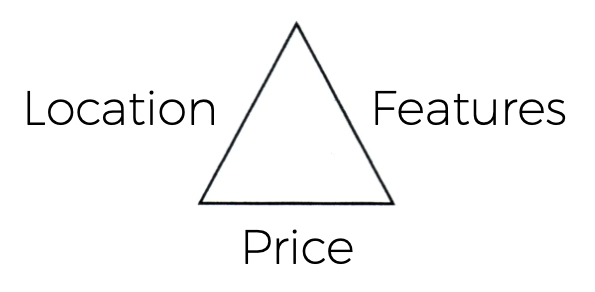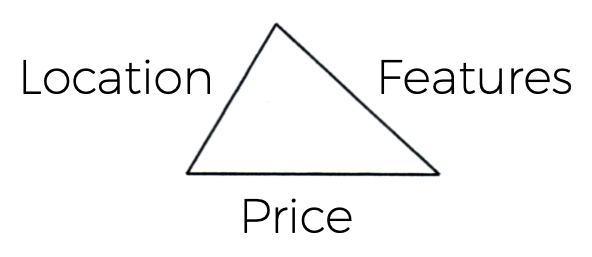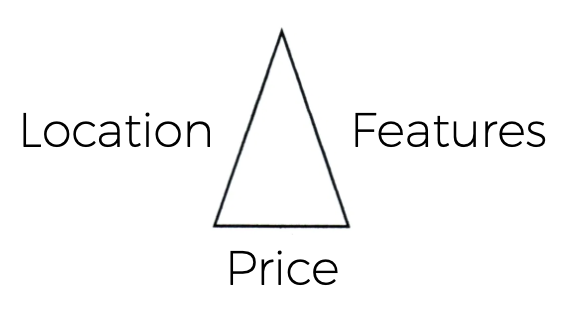
Buying a home is an exciting time, but is it really possible to get EVERYTHING you want?
When we’re speaking with a buyer about their wish list for their next home, we like to categorize what they want into three different “buckets” that will help us advise them about their best options.
First, is LOCATION. How close do they want to be to work? Friends and family? Do they want a quiet location away from the activity, or an urban setting that’s walking distance to everything?
Then there are FEATURES. Open concept layout, or more closed off? Do they want a pool, or do they absolutely NOT want a pool? Number of bedrooms, lot size, finished basement… all of these are features that can be important to buyers.
Finally, there’s the PRICE. What’s the budget? We like to think of the budget more from the perspective of the upfront cost and the ongoing cost first, and then build that back up into a purchase price.
Just because the bank allows a buyer to buy for a certain number doesn’t mean it’s a good idea.
The way all of these factors work together looks like a triangle. Sometimes the sides are nice and even when there are no constrains, but most of the time they’re unbalanced and NOT even.
When one or two of these three becomes more of a priority, the triangle shifts.
For example, in the second diagram below, the features and price have now become longer than the location side.
Depending on your perspective for this example, you can interpret this one of two ways:
1. The location is MOST important, and the buyer is willing to sacrifice the features of a home and/or the price to get into the right area. They might be willing to pay more in order to be close to work, or buy a fixer-upper in the right neighbourhood that will appreciate.
2. The location is LESS important, and the buyer could be willing to go further away in order to get the right size of home, or the home that will fit their limited budget.

Likewise, when the price side gets smaller (see below), it can mean that the buyer’s criteria puts price ahead of the other two features, or it could mean that location and features are MORE important than price.
In other words, the buyer could have a lot of flexibility in their budget, but they really want a specific set of features, possibly only in a certain school district or neighbourhood.

However in most cases, a buyer is limited with a maximum budget by their mortgage lender, so this will cause them to look at the other two – LOCATION and FEATURES – to choose their most important “must haves”.
That’s the most common thing we see.
I just spoke to first-time buyers tonight that have a budget of $550,000 and they’re considering less expensive Guelph, or Milton/Burlington if they can find something in their budget.
That’s a real-life example of the Buyer’s Triangle at work.
Can your triangle change during your home search?
Absolutely.
Once you begin exploring your options, you might find that you can get more home than you expected for the budget, or that you don’t mind driving a bit more to work because the homes are SO much better a little further out.
Every home search is different, but it’s a good idea to start with some kind of a plan about your LOCATION, FEATURES AND PRICE, because the Cheshire Cat from Alice in Wonderland said it best:
“If you don’t know where you’re going, any road will get you there.”
Another quote about planning that we love:
“A meaningful specific will always beat a wandering generality.”
Get clear about your criteria and your values when searching for a home, and your choices will become so much clearer.
You’ll save time and energy, and it will be a much more enjoyable search.
If you need a hand with some thoughtful questions to help you gain clarity about your home buying journey, just reach out to any member of our team. We’ll be glad to assist you… by asking the questions most agents don’t, and by pointing out all the things you should know so that there are no surprises.